
3 minute read
The Birds in your Garden
Bird Flocks in your Garden
Autumn is with us, and winter approaches, and this is the time of year when some garden birds form flocks. Birds normally only do things that help them survive, and it’s generally thought that flocks help with protection from predators (more eyes to spot them and a swirl of targets to confuse them), roosting warmth and locating food.
Advertisement
Species behave differently, but whatever they get up to, the result can be spectacular as anyone watching a Starling murmuration will witness. Reserves such as Potteric Carr and Saltholme are good places to see murmurations, but they occur all over the country involving anything from a few hundred to hundreds of thousands. I’ve heard a couple of suggestions for the choice of the collective noun; one is that it is from the sound of myriad wings in flight, and the other that it comes from the noise they make after they have settled. Take your choice!
Less dramatic, but well worth a closer look, are the finch flocks which are around at the moment. Breeding out of the way, so no need to compete, and with juveniles in abundance, and often large numbers of migrants here for our less intense winters, they get together in flocks that can vary from a dozen to hundreds. Migrant finches tend to feed out in the fields, so those you see in your garden are most likely residents.
Goldfinches are probably the species most often seen in flocks these days, with their numbers being on the increase in contrast to those of Greenfinches and Chaffinches, which are well down, due mainly to trichomonosis, and still falling.
If you do see a Chaffinch flock, have a look to see whether it is predominantly composed of males or females. Linnaeus in 1758 named the species Coelebs (bachelor) because wintering birds in his native Sweden were almost exclusively male. The females gathered elsewhere, usually to the west and south!
Sounding something like a tinkling of bells the Goldfinch’s song en masse has earned them the rather lovely collective noun, ‘Charm’. Look more closely though, and you’ll see that most flocks are mixed. Greenfinches, Chaffinches, and occasionally Bullfinches are the most common companions, but Siskins, Bramblings and maybe even the odd vagrant can get involved. It’s always worth a second (and third) look, particularly if your binoculars are handy.
If you do see a flurry of small-bird movement, take a few moments to look and see whether it’s just a few sparrows arguing, or whether it’s a larger flock of something else moving through. It’s not just finches that flock, either. Tits have the same tendency, so again, have a second look. It may seem as though they are all the same, but Long Tailed Tits and various assorted other species often get mixed in.
In most cases, birds in a flock tend to be very restive. Life in a flock is rarely particularly harmonious, and if birds get too close to each other, especially when feeding, there will be a flurry of aggressive calls and much fluttering of wings. There are always one or two nervous characters in there, and if it is a mixed flock, there’s a good chance that some of the movements will be a group of the same species, helping you work out what’s included. Look at body shapes and beaks as well as colour, they are probably the best way of sorting out who is there.
If you find the lives of our garden birds to be of interest, and would like to join in and count the feathered occupants of your garden, please contact the BTO Garden BirdWatch website (www.bto.org/gbw). Mike Gray gbwmike@gmail.com.












